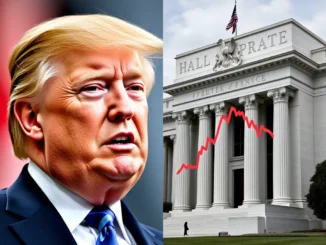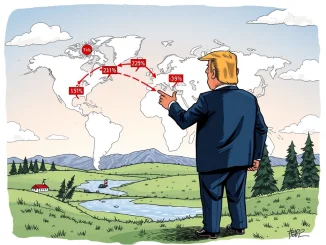
In the ever-evolving landscape of global finance, major geopolitical and economic shifts can send ripples across markets, influencing everything from stocks to, yes, even cryptocurrencies. While seemingly distant, a significant development has emerged concerning the **US China trade agreement**, a topic that has dominated headlines and investor concerns for years. A reported breakthrough in tariff negotiations between the two economic giants could signal a notable change in the global economic climate. How might this affect the broader financial ecosystem that crypto inhabits?
Understanding the **US China Trade Agreement** Context
For several years, the world’s two largest economies have been locked in a contentious trade dispute, often dubbed the “trade war.” This conflict involved the imposition of substantial tariffs on hundreds of billions of dollars worth of goods exchanged between the two nations. The stated goals on both sides varied, but the result was increased costs for businesses and consumers, disruption of supply chains, and heightened uncertainty in the **global economy**.
This period of elevated trade tensions has had a tangible **economic impact** worldwide, slowing growth and altering international trade flows. Against this backdrop, any movement towards de-escalation is significant, potentially paving the way for smoother international commerce and greater economic predictability.
Details of the Reported **Tariff Reduction**
According to reports, including from South Korean newspaper Chosun Ilbo, a major step has been taken to ease these tensions. The core of the reported agreement involves a substantial **tariff reduction**:
- The U.S. has reportedly agreed to lower tariffs on Chinese goods from a staggering 145% to 30%.
- China, in turn, has reportedly cut tariffs on U.S. imports from 125% to a significantly lower 10%.
These reported figures represent a dramatic rollback of the punitive tariffs imposed during the height of the **trade war**. Furthermore, Chinese news outlets have indicated that various non-tariff retaliatory measures, which added further friction to trade, are also slated for removal.
This level of **tariff reduction** is far more significant than previous, smaller adjustments or exemptions, suggesting a more fundamental shift in approach.
Expected **Economic Impact** on Both Nations and the **Global Economy**
Officials within China, such as the Chinese Customs Tariff Commission of the State Council, have voiced optimism regarding this development. They state that the **tariff reduction** aligns with the expectations of producers and consumers in both the U.S. and China. What does this mean in practical terms?
- For Businesses: Lower tariffs mean reduced costs for importing raw materials, components, and finished goods. This can improve profit margins, make products more competitive, and potentially lead to increased investment.
- For Consumers: Reduced import costs can translate into lower prices for a wide range of goods, increasing purchasing power.
- For Trade Volume: With reduced barriers, the volume of trade between the two countries is expected to increase, boosting economic activity.
Beyond the direct bilateral benefits, this agreement is anticipated to positively impact the **global economy**. As the two largest economies trade more freely, it can reduce uncertainty, stabilize supply chains, and foster a more predictable international trading environment, benefiting countries that are part of the global supply chain connected to the U.S. and China.
Navigating the Path Forward After the **Trade War**
While this **tariff reduction** is a major step, it’s important to note that it doesn’t signify the absolute end of negotiations. According to the reports, the two countries will continue discussions over specific details for a period of 90 days. This suggests that while the broad strokes of a significant agreement are in place, finer points, enforcement mechanisms, and potentially other trade issues are still being worked out.
This 90-day period represents a crucial phase. Successful navigation of these detailed negotiations will be key to solidifying the reported gains and ensuring the long-term stability of the **US China trade agreement**. Any hitches during this period could introduce renewed uncertainty, though the initial reported cuts indicate a strong commitment to de-escalation.
What Does This Mean for the Financial Landscape?
While not directly a cryptocurrency story, major shifts in the **global economy** like a significant **tariff reduction** between the U.S. and China have broader financial implications. Reduced trade tensions can lead to increased investor confidence, potentially shifting capital flows. A more stable global economic outlook might influence investment decisions across various asset classes. For crypto investors, understanding these macro-economic trends is crucial as they can indirectly affect market sentiment and volatility.
Summary: A Positive Step Towards Easing Trade Tensions
The reported **tariff reduction** agreement between the U.S. and China marks a potentially breakthrough moment in their recent trade history. With substantial cuts to import duties on both sides and the removal of non-tariff barriers, the agreement aims to boost economic exchanges and provide a positive **economic impact** on the **global economy**. While details are still being negotiated over the next 90 days, this move signals a significant de-escalation in the long-running **trade war** and offers hope for a more stable and prosperous international trade environment.



